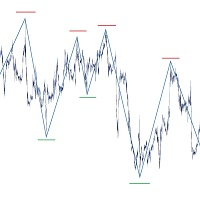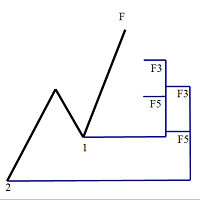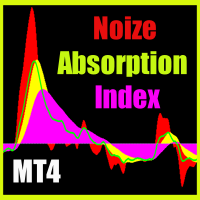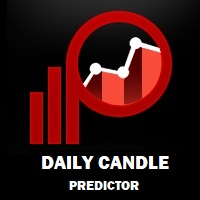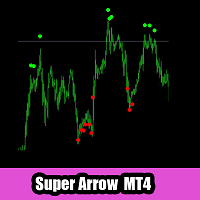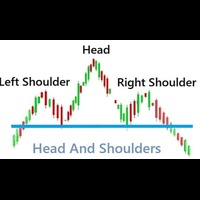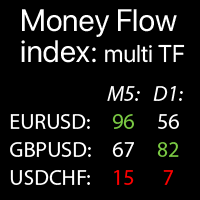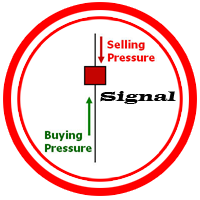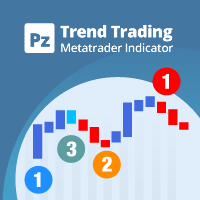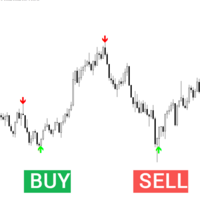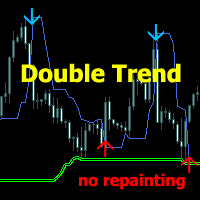Forecast Session Deviation
- 지표
- Richard Caughell
- 버전: 4.0
- 업데이트됨: 19 6월 2025
- 활성화: 15
🎯 Product Overview
Forecast Session Deviation is a sophisticated trading indicator that identifies key market session zones and projects future price behavior based on historical patterns. By analyzing specific session anchors (like the Tokyo session), it creates visual zones that help traders anticipate where price is likely to move, complete with multi-level deviation bands for risk management.
Key Features:
- ✅ Automatic session detection and zone mapping
- ✅ Visual projection zones showing expected price ranges
- ✅ Multi-level deviation bands (1x, 2x, 3x zone height)
- ✅ Win/loss tracking with visual markers (checkmarks, X's, neutral boxes)
- ✅ Real-time statistics panel showing success rates
- ✅ Flexible signal logic with multiple trading modes
- ✅ Interactive controls for dynamic adjustments
- ✅ Forward projection lines for active trades
- ✅ Debug mode for setup verification
📊 How It Works
- Session Identification: The indicator identifies specific market sessions (default: Tokyo 3:00 UTC Thursday)
- Zone Creation: Creates an "anchor zone" from session high/low
- Projection: Projects this zone forward to predict next week's price movement
- Outcome Tracking: Marks whether price followed the predicted direction
- Statistical Analysis: Tracks win rates and deviation frequencies
Why Thursday? The Strategic Session Choice📅 Thursday: The Post-Fed Clarity Day
Forecast Session Deviation defaults to Thursday sessions for a powerful reason: Thursday represents the market's true reaction to the week's fundamental events.
🏛️ The Fed Effect
Wednesday: Fed Day
- FOMC meetings typically conclude on Wednesdays
- Fed interest rate decisions announced Wednesday at 2:00 PM EST (19:00 UTC)
- Initial market reaction is often chaotic and whipsaw-prone
- Algorithms and news traders create excessive volatility
Thursday: True Direction Day
- Markets have digested the Fed news overnight
- Asian session (our 3:00 UTC anchor) shows the first stable reaction
- Institutional positioning becomes clear
- The "real" trend often emerges after the noise settles
💡 Why This Matters for Your Trading
-
Cleaner Zones: Thursday's anchor captures post-news equilibrium, not news spike chaos
-
Better Projections: The market's true sentiment (not knee-jerk reactions) projects more reliably into the following week
-
Institutional Footprints: Large players position themselves Thursday after analyzing Fed policy - you're following smart money
-
Weekly Cycle: Thursday sits perfectly to capture the week's developed trend before Friday's position squaring
📊 Other Key Thursday Events
Beyond the Fed, Thursdays often feature:
- ECB rate decisions (European Central Bank)
- BoE decisions (Bank of England)
- Weekly jobless claims (US)
- Post-news technical setups
🎯 The Bottom Line
By anchoring on Thursday, you're measuring the market's informed reaction rather than its initial shock. This gives you zones based on:
- ✅ Institutional positioning
- ✅ Digested fundamentals
- ✅ Reduced noise
- ✅ True market sentiment
"Trade the reaction, not the news" - and Thursday shows you the real reaction.
Pro Tip: While Thursday is optimal for major pairs, you can adjust for other central banks:
- Tuesday for RBA (Australian Dollar)
- Friday for BoJ decisions (Japanese Yen)
- Wednesday for BoC (Canadian Dollar)
The key is capturing the first stable session after major fundamental events.
⚙️ Input Parameters Guide
🕐 Session Timing Settings
-
Anchor Day of Week (0-6)
- Default: 4 (Thursday)
- 0=Sunday, 1=Monday... 6=Saturday
- Determines which day to capture the anchor session
-
Anchor Hour (0-23)
- Default: 3 (3:00 UTC)
- The hour when the anchor session begins
-
Anchor Minute (0-59)
- Default: 0
- Fine-tune the exact start time
-
Anchor Session Length (bars)
- Default: 12
- Range: 1-48
- How many bars make up the anchor session
📈 Display Settings
-
Number of Past Anchors
- Default: 10
- How many historical sessions to display
-
Show Labels (true/false)
- Default: true
- Display "Anchor 1, 2, 3..." labels
-
Show Statistics Panel (true/false)
- Default: true
- Display win rate and performance stats
-
Show Trend Lines (true/false)
- Default: true
- Draw lines from anchor close to projection close
-
Show Breakout Arrows (true/false)
- Default: true
- Display directional arrows at session close
-
Show Weekly Finish Markers (true/false)
- Default: true
- Show checkmarks/X symbols at projection end
-
Show Controls (true/false)
- Default: true
- Display interactive +/- buttons for anchor length
🎨 Color Settings
-
Anchor Zone Color
- Default: Hot Pink
- The main session box color
-
Projection Zone Color
- Default: Pale Turquoise
- The forecast zone color
-
Bullish Win Color
- Default: Green
- Color for successful bullish predictions
-
Bearish Win Color
- Default: Red
- Color for successful bearish predictions
-
Neutral Color
- Default: Gray
- Color when price stays within zone
📏 Deviation Zone Settings
-
Show Deviations (true/false)
- Default: true
- Enable/disable deviation bands
-
Deviation Multipliers (1, 2, 3)
- Default: 1.0 , 2.0 , 3.0
- Multiples of zone height for each level
-
Deviation Colors (1, 2, 3)
- Default: Old Lace , Peach , Light Pink
- Colors for each deviation level
-
Deviation Transparency (0-255)
- Default: 30
- 0=invisible, 255=opaque
🔮 Forward Projection Settings
-
Show Forward Projection (true/false)
- Default: true
- Display projection lines for active zones
-
Forward Projection Color
- Default: Light Pink
- Color for future projection lines
-
Forward Projection Style
- Default: STYLE_DOT
- Line style (solid, dash, dot, etc.)
🎯 Signal Logic Settings (Advanced)
-
Use Anchor High/Low (true/false)
- Default: true
- true : Anchor direction based on Close vs Open
- false : Anchor direction based on Close vs Midpoint
-
Compare to Anchor Close (true/false)
- Default: false
- true : Compare weekly close to anchor close price
- false : Compare weekly close to zone high/low
🐛 Debug Settings
-
Show Debug Info (true/false)
- Default: false
- Display technical information panel
-
Show Signal Debug (true/false)
- Default: false
- Print detailed signal logic to Experts tab
-
Text Size
- Default: 8
- Size for outcome text labels
💡 Usage Tips
For Beginners:
- Start with default settings
- Focus on Hot Pink zones (anchors) and Turquoise zones (projections)
- Green arrows = bullish session, Red arrows = bearish session
- Checkmarks = successful prediction, X = failed prediction
For Advanced Users:
- Experiment with different session times for your market
- Adjust deviation multipliers based on volatility
- Try different signal logic modes for various strategies
- Use debug mode to verify your settings
Best Practices:
- Use on H1 timeframe or higher for best results
- Allow 20+ historical anchors to load for accurate statistics
- Combine with other indicators for confirmation
- Pay attention to deviation level breaches for volatility assessment
📊 Understanding the Statistics Panel
The panel shows:
- Total Anchors: Number of sessions analyzed
- Completed: How many have finished projections
- Win Rate: Percentage of correct predictions
- Deviation Stats: How often price reaches each level
🚀 Getting Started
- Install: Add indicator to any forex pair
- Configure: Adjust session time to your target market
- Observe: Watch how price respects the zones
- Trade: Use zones for entry/exit decisions
- Track: Monitor your success rate in the stats panel
Forecast Session Deviation - Transform session patterns into profitable predictions
🎯 Pro Tip:
Start with the session most relevant to your traded pairs:
- Trading EUR/USD? → Use London (10:00 UTC)
- Trading USD/JPY? → Use Tokyo (03:00 UTC)
- Trading AUD/USD? → Use Sydney (00:00 UTC)
- Trading during US hours? → Use New York (15:00 UTC)
The indicator will automatically track how well each session's range predicts the following week's movement!
📊 The Power of Zone-Based Pip Projection
Forecast Session Deviation transforms traditional support and resistance into dynamic pip measurement tools. By capturing a specific market session's range and projecting it forward, traders gain a mathematical framework for understanding potential price movement.
🎯 How the Zones Reveal Pip Potential
1. The Anchor Zone - Your Baseline
The anchor zone captures the high and low of your chosen session, creating a "measuring stick" for future price movement.
Example:
- Tokyo session creates a 50-pip zone (1.1000 to 1.1050)
- This 50-pip range becomes your base unit of measurement
- All future movements are measured in multiples of this zone
2. The Projection Zone - Expected Range
This zone projects the anchor's height forward in time, showing where price "should" trade if it respects the session's influence.
What it tells you:
- Price within zone = Normal, expected movement
- Price at zone edges = Decision point approaching
- Price breaking zone = Momentum building
📏 Deviation Levels - Measuring Explosive Moves
Understanding the Multiplier System
Each deviation level represents multiples of your anchor zone height:
1x Deviation (Level 1)
- Meaning: Price has moved one full zone height beyond the anchor
- 50-pip zone example: 50 pips above high or below low
- Trading insight: Strong directional bias confirmed
2x Deviation (Level 2)
- Meaning: Price has moved two zone heights
- 50-pip zone example: 100 pips beyond the zone
- Trading insight: Exceptional momentum, possible exhaustion
3x Deviation (Level 3)
- Meaning: Price has moved three zone heights
- 50-pip zone example: 150 pips beyond the zone
- Trading insight: Extreme move, high probability of reversal
💡 Practical Pip Targeting Strategies
Strategy 1: Zone Edge Trading
Entry: When price touches projection zone edge Target 1: Opposite zone edge (1x zone height in pips) Target 2: 1x deviation level (2x zone height total) Stop Loss: Just beyond 1x deviation
Example with 40-pip zone:
- Entry: Zone high at 1.1040
- Target 1: Zone low at 1.1000 (40 pips)
- Target 2: Lower 1x deviation at 1.0960 (80 pips)
- Stop: 10 pips beyond entry (50 pips risk)
Strategy 2: Breakout Continuation
Entry: When price closes beyond projection zone Target 1: 1x deviation (1 zone height from edge) Target 2: 2x deviation (2 zone heights from edge) Stop Loss: Middle of projection zone
Example with 60-pip zone:
- Breakout above 1.1060
- Target 1: 1.1120 (60 pips)
- Target 2: 1.1180 (120 pips)
- Stop: 1.1030 (30 pips risk)
Strategy 3: Deviation Reversal
Entry: When price reaches 2x or 3x deviation Target: Return to projection zone Stop Loss: Beyond 3x deviation Risk/Reward: Often 1:3 or better
📈 Real-World Application Examples
Scenario 1: London Session Breakout
- London anchor zone: 80 pips (1.1200-1.1280)
- Price breaks above to 1.1360 (1x deviation)
- Pip potential: Additional 80-160 pips if momentum continues
- Risk: 40 pips (half zone height)
Scenario 2: Tokyo Range Reversal
- Tokyo anchor zone: 45 pips
- Price reaches 2x lower deviation (-90 pips from zone)
- Reversal potential: 90+ pips back to zone
- Ultra-conservative target: 45 pips to 1x deviation
Scenario 3: New York Continuation
- NY anchor zone: 100 pips
- Strong trend takes price through 1x, approaching 2x
- Trend following potential: 200-300 total pips
- Scaling strategy: Take profits at each deviation level
🎯 Advanced Pip Calculation Features
Multi-Timeframe Zone Analysis
- H1 zones for intraday: 30-80 pip targets
- H4 zones for swing: 100-200 pip targets
- Daily zones for position: 200-500 pip targets
Volatility-Adjusted Targets
- Tight 20-pip zones = Lower pip targets, tighter stops
- Wide 100-pip zones = Larger pip targets, wider stops
- Key: Risk/reward ratio remains constant
Statistical Edge
The indicator tracks success rates at each level:
- "73% of moves beyond 1x deviation return to zone"
- "Only 15% of moves reach 3x deviation"
- Use these stats to size positions and set realistic targets
🚀 Maximizing Your Pip Potential
1. Let the Zone Define Your Targets
Instead of arbitrary pip targets, use zone multiples:
- Conservative: 0.5x zone height
- Standard: 1x zone height
- Aggressive: 2x zone height
2. Scale Your Position
- Enter 50% at zone edge
- Add 30% at breakout confirmation
- Final 20% on pullback to zone
3. Use Deviation Stats
If only 20% reach 2x deviation:
- Take 80% profits at 1x deviation
- Let 20% run to 2x or 3x
📝 Quick Reference - Pip Calculations
For any zone height (H):
- Projection zone = H pips of expected movement
- 1x deviation = H additional pips beyond zone
- 2x deviation = 2H additional pips
- 3x deviation = 3H additional pips
Total movement potential:
- To 1x level: 2H pips from opposite zone edge
- To 2x level: 3H pips from opposite zone edge
- To 3x level: 4H pips from opposite zone edge
Example with 50-pip zone:
- Normal range: 50 pips
- To 1x deviation: 100 pips total
- To 2x deviation: 150 pips total
- To 3x deviation: 200 pips total
With Forecast Session Deviation, you're not just guessing pip targets - you're measuring them mathematically based on proven market session dynamics.






